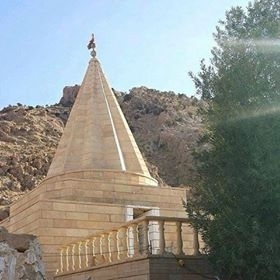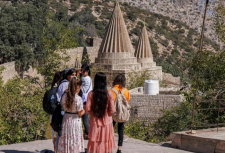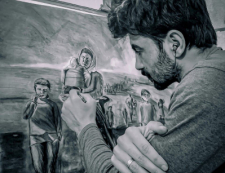History of religion

Part 1
Igor Bazilenko — doctor of historical Sciences, leading researcher at the Institute of Oriental manuscripts of the Russian Academy of Sciences, Professor of St. Petersburg state University, Professor of St. Petersburg theological Academy.
The great A. S. Pushkin introduced the concept of "Yazidis" to the wide Russian public in his famous "Journey to Arzrum during the campaign of 1829", describing his meeting and conversation with a yazidian Sheikh. About a century ago, corresponding member of the Imperial Academy of Sciences N. I. Veselovsky (1848-1918) believed that the Yazidis are followers of "one, quite mysterious, religious sect that spread among the Kurds." Ethnographic reference book "Peoples of the world" in 1988 called yazidism "syncretic cult". The "atheist's Handbook" of Soviet times and the post-Soviet dictionary "Races and peoples" of 2007 characterized yazidism as an independent religion. Acute scientific debate is still the question of whether this creed professes part of the Kurds or a separate ethnic community called "Yazidis". As you know, yazidism or sharfadin (from "sharfaden") is an exclusive ethnic religion, inherent to the Kurds. At the same time, due to the endogamous nature of yazidism, many researchers, as well as the Kurds themselves, who do not profess yazidism, consider Yazidis to be a separate ethno-confessional community.
Researchers-kurdologists have repeatedly noted that the religion of the Kurds is dependent on the religion of the bulk of the population of those countries in which the Kurdish communities live compactly. About half of all Kurds (more than 20 million) live in the territory of the Republic of Turkey. Thus, most Kurds are Sunni Muslims. In the Republic of Turkey and the Syrian Arab Republic, the alevite Kurds are densely settled. There are Christians among the Kurds, there are followers of the religion "Yarsan" ("community of friends") or "AHL-e-Haqq" ("people of truth"), Yazidis. We can say that the Kurds are not peculiar to religious Orthodoxy, as such. Having experienced the Muslim sermon, the Kurds, even in the late middle Ages, have not yet fully converted to Islam and often prefer the most heterodox varieties, such as the aforementioned alevism. Features of the religious mentality of the Kurds are largely associated with the country of residence and the peculiarities of local ethnic and religious policy. Thus, in Iraqi Kurdistan, Kurds are generally less religious than Kurds living in the Islamic Republic of Iran on the territory of Iranian Kurdistan. The religiosity of the Kurdish population can also vary markedly not only depending on the legislation of the country, but also on the degree of urbanization of a number of areas or regions. On the territory of the Russian Federation, the majority of Kurds profess yazidism, because historically, most Russian Kurds come from the Caucasus, which became the main region of residence of Yazidis after the deportation of Muslims from there to the Central Asian republics of the USSR. Modern Yazidis are often classified as "Yazdani" with "Alevis" and "AHL al-Haqq and".
The etymology of the word "yazidism" is quite complex and confusing, there are about a dozen versions of the origin. In one common version of this "yazidism" dates back to Persian "yazdan" — "God", "vessel of sacrifice". There is also no common theory about the origin of yazidism.
Because of the persecution of Muslims, the closed nature of the religion, as well as the oral nature of the transmission of religious tradition, yazidism is still not well understood. In modern science there are two opposing points of view regarding the age of yazidism and ethnicity of the first Yazidis. Modern researchers of the Kurdish of Yazidism (H. Omarkhali /Usoyan/) believe that the Kurds professed Yazidism as an ethnic religion long before the victory of Islam in the region, and the Yazidism, thus, is the ancient religion of the Kurdish tribes, which reformed the extremely revered in the Yazidism of Shaykh ADI Ibn Musafir (about 1073 — circa 1164). Other researchers (V. Arakelova) believe that the creation of syncretic creeds of the Yazidis ("Yazidism" is regarded as a misnomer) is directly connected with the activities of the native of the city of Baalbek to the Syrian Shaykh ADI Ibn Musafir, which was created in XI century adawiyya Sufi tariqa. In the depths of the Sufi organizations came to the XIV−XV centuries Yazidism as a pretty young ethno confessional system, early adherents of which, in the opinion of Aracinovo, was not only the Kurds, but Arabs, Syrians and so on. Despite the incomparably more developed oral religious tradition, modern yazidism has its own Scripture, represented by two books: "Keteb-e Gilve" ("Book of Manifestation"), written on behalf of Malik Taus presumably in 1162-1163. Secretary Shaykh ADI, which includes an introduction and five chapters, divided into 45 short paragraphs, which sets out the essence of the creed, and "Moshaf-e rush" ("Black scroll"), containing historical information, the rules of the celebration of the new year Yazidis, meals, description of marriage rites, etc.
Both books appeared after the emergence of Islam, made a mystery of 35 letters, and the presence of them became known only at the end of the XIX century. In 1911, the priest of the Catholic order of Carmelites Anastas Marie received copies of both books, which were published without decoding. In order to protect the Yazidi religious tradition from the uninitiated, it was encrypted with the help of a cryptography created partly on the basis of the Arabic and Aramaic alphabets. Austrian orientalist Maximilian Bittner translated these works (the font was close to Nestorian writing, but, nevertheless, independent) and in 1913 published in Vienna in German. The first Russian translation was made in 1927 by the employee of Tashkent Central Asian state University A. A. Semenov. In 1991, the candidate of Philology, Cherkase rush, completed and published a translation of both works in the alphabet of the Soviet Kurds (based on Cyrillic) in Yerevan .8 Questions about the authorship and timing of these works remain open. There is an assumption that these small treatises are the latest interpretations of the more ancient and extensive sacred tradition of the Yazidis called "Zabun" and "Mshur", which is still kept secret by the spiritual heads of the community. They are conventionally dated to the XII century., when the skin of the Gazelle Arabic script were made 40 lists, which were listed pedigrees 40 families of Yazidi clergy from the caste of pirs.
Then the manuscripts were handed over to the representatives of these genera. Several copies were kept in Iraq and at least one in Armenia. Until recently, only the Yazidi clergy had the right to read and interpret these texts. Yazidis have a belief that if a person who does not belong to the family that owns the list, will read the text — he can go blind or die. So many people have seen "Msur", but few people dared to read it. It is believed that until 1970, when the spiritual leaders of the Yazidis allowed to record the sacred tradition, it was transmitted orally from generation to generation for many centuries. In addition to the above books, sources for the study of the Yazidi creed are religious hymns "Qawl" ("Kaul") — "word, speech" and mythological chants "Bayt" — "couplets".
The oldest qawl is called "Qawle Khode" ("God's Word"). There are also the "Qawl-e Kochak," "Qawl-e Chez Shams", "Qawl-e Mishina Measure", "Qawl-e Aside the World", "Qawl-e sibak well Adabia", "Qawl-e Bora Bora", "Qawl-e Iman", "Qawl-e-Maan", "Qawl-e Sharfadin", etc. To numerous genres of the prayers and hymns of the Yazidis include also "Dua", "Jandel", "durus" and "mohabat", who perform Qawwali constituting a special spiritual class in yezidism. Currently, religious hymns and ritual chants of Yazidis are recorded in writing and translated into various languages. The sacred texts of the Yazidis were fragmentally included in textbooks for schools in Dahuk province of Mosul governorate, where along with the teaching of the basics of Islam was officially taught the basics of yazidism.
Tags: #yazidis #ezidi #ezidxan
History of religion

Part 1
Igor Bazilenko — doctor of historical Sciences, leading researcher at the Institute of Oriental manuscripts of the Russian Academy of Sciences, Professor of St. Petersburg state University, Professor of St. Petersburg theological Academy.
The great A. S. Pushkin introduced the concept of "Yazidis" to the wide Russian public in his famous "Journey to Arzrum during the campaign of 1829", describing his meeting and conversation with a yazidian Sheikh. About a century ago, corresponding member of the Imperial Academy of Sciences N. I. Veselovsky (1848-1918) believed that the Yazidis are followers of "one, quite mysterious, religious sect that spread among the Kurds." Ethnographic reference book "Peoples of the world" in 1988 called yazidism "syncretic cult". The "atheist's Handbook" of Soviet times and the post-Soviet dictionary "Races and peoples" of 2007 characterized yazidism as an independent religion. Acute scientific debate is still the question of whether this creed professes part of the Kurds or a separate ethnic community called "Yazidis". As you know, yazidism or sharfadin (from "sharfaden") is an exclusive ethnic religion, inherent to the Kurds. At the same time, due to the endogamous nature of yazidism, many researchers, as well as the Kurds themselves, who do not profess yazidism, consider Yazidis to be a separate ethno-confessional community.
Researchers-kurdologists have repeatedly noted that the religion of the Kurds is dependent on the religion of the bulk of the population of those countries in which the Kurdish communities live compactly. About half of all Kurds (more than 20 million) live in the territory of the Republic of Turkey. Thus, most Kurds are Sunni Muslims. In the Republic of Turkey and the Syrian Arab Republic, the alevite Kurds are densely settled. There are Christians among the Kurds, there are followers of the religion "Yarsan" ("community of friends") or "AHL-e-Haqq" ("people of truth"), Yazidis. We can say that the Kurds are not peculiar to religious Orthodoxy, as such. Having experienced the Muslim sermon, the Kurds, even in the late middle Ages, have not yet fully converted to Islam and often prefer the most heterodox varieties, such as the aforementioned alevism. Features of the religious mentality of the Kurds are largely associated with the country of residence and the peculiarities of local ethnic and religious policy. Thus, in Iraqi Kurdistan, Kurds are generally less religious than Kurds living in the Islamic Republic of Iran on the territory of Iranian Kurdistan. The religiosity of the Kurdish population can also vary markedly not only depending on the legislation of the country, but also on the degree of urbanization of a number of areas or regions. On the territory of the Russian Federation, the majority of Kurds profess yazidism, because historically, most Russian Kurds come from the Caucasus, which became the main region of residence of Yazidis after the deportation of Muslims from there to the Central Asian republics of the USSR. Modern Yazidis are often classified as "Yazdani" with "Alevis" and "AHL al-Haqq and".
The etymology of the word "yazidism" is quite complex and confusing, there are about a dozen versions of the origin. In one common version of this "yazidism" dates back to Persian "yazdan" — "God", "vessel of sacrifice". There is also no common theory about the origin of yazidism.
Because of the persecution of Muslims, the closed nature of the religion, as well as the oral nature of the transmission of religious tradition, yazidism is still not well understood. In modern science there are two opposing points of view regarding the age of yazidism and ethnicity of the first Yazidis. Modern researchers of the Kurdish of Yazidism (H. Omarkhali /Usoyan/) believe that the Kurds professed Yazidism as an ethnic religion long before the victory of Islam in the region, and the Yazidism, thus, is the ancient religion of the Kurdish tribes, which reformed the extremely revered in the Yazidism of Shaykh ADI Ibn Musafir (about 1073 — circa 1164). Other researchers (V. Arakelova) believe that the creation of syncretic creeds of the Yazidis ("Yazidism" is regarded as a misnomer) is directly connected with the activities of the native of the city of Baalbek to the Syrian Shaykh ADI Ibn Musafir, which was created in XI century adawiyya Sufi tariqa. In the depths of the Sufi organizations came to the XIV−XV centuries Yazidism as a pretty young ethno confessional system, early adherents of which, in the opinion of Aracinovo, was not only the Kurds, but Arabs, Syrians and so on. Despite the incomparably more developed oral religious tradition, modern yazidism has its own Scripture, represented by two books: "Keteb-e Gilve" ("Book of Manifestation"), written on behalf of Malik Taus presumably in 1162-1163. Secretary Shaykh ADI, which includes an introduction and five chapters, divided into 45 short paragraphs, which sets out the essence of the creed, and "Moshaf-e rush" ("Black scroll"), containing historical information, the rules of the celebration of the new year Yazidis, meals, description of marriage rites, etc.
Both books appeared after the emergence of Islam, made a mystery of 35 letters, and the presence of them became known only at the end of the XIX century. In 1911, the priest of the Catholic order of Carmelites Anastas Marie received copies of both books, which were published without decoding. In order to protect the Yazidi religious tradition from the uninitiated, it was encrypted with the help of a cryptography created partly on the basis of the Arabic and Aramaic alphabets. Austrian orientalist Maximilian Bittner translated these works (the font was close to Nestorian writing, but, nevertheless, independent) and in 1913 published in Vienna in German. The first Russian translation was made in 1927 by the employee of Tashkent Central Asian state University A. A. Semenov. In 1991, the candidate of Philology, Cherkase rush, completed and published a translation of both works in the alphabet of the Soviet Kurds (based on Cyrillic) in Yerevan .8 Questions about the authorship and timing of these works remain open. There is an assumption that these small treatises are the latest interpretations of the more ancient and extensive sacred tradition of the Yazidis called "Zabun" and "Mshur", which is still kept secret by the spiritual heads of the community. They are conventionally dated to the XII century., when the skin of the Gazelle Arabic script were made 40 lists, which were listed pedigrees 40 families of Yazidi clergy from the caste of pirs.
Then the manuscripts were handed over to the representatives of these genera. Several copies were kept in Iraq and at least one in Armenia. Until recently, only the Yazidi clergy had the right to read and interpret these texts. Yazidis have a belief that if a person who does not belong to the family that owns the list, will read the text — he can go blind or die. So many people have seen "Msur", but few people dared to read it. It is believed that until 1970, when the spiritual leaders of the Yazidis allowed to record the sacred tradition, it was transmitted orally from generation to generation for many centuries. In addition to the above books, sources for the study of the Yazidi creed are religious hymns "Qawl" ("Kaul") — "word, speech" and mythological chants "Bayt" — "couplets".
The oldest qawl is called "Qawle Khode" ("God's Word"). There are also the "Qawl-e Kochak," "Qawl-e Chez Shams", "Qawl-e Mishina Measure", "Qawl-e Aside the World", "Qawl-e sibak well Adabia", "Qawl-e Bora Bora", "Qawl-e Iman", "Qawl-e-Maan", "Qawl-e Sharfadin", etc. To numerous genres of the prayers and hymns of the Yazidis include also "Dua", "Jandel", "durus" and "mohabat", who perform Qawwali constituting a special spiritual class in yezidism. Currently, religious hymns and ritual chants of Yazidis are recorded in writing and translated into various languages. The sacred texts of the Yazidis were fragmentally included in textbooks for schools in Dahuk province of Mosul governorate, where along with the teaching of the basics of Islam was officially taught the basics of yazidism.
Tags: #yazidis #ezidi #ezidxan


























